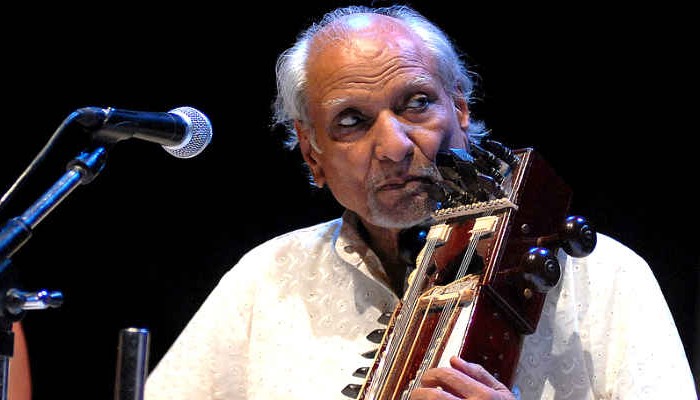
Are the proponents of science and religion running into conflict in a bid to establish supremacy?

Ustad Sabri Khan who died in Delhi earlier this month was a sarangi player par excellence. He visited Pakistan in the late 1980s and gave a very good amount of his talent as a sarangi maestro. He was accompanied by his son, Kamal, who was then in his teens and showed the promise that was later fulfilled. Today, he is one of the leading sarangi players of India. Audiences in Pakistan are also familiar with his other son, Sarwar Sabri, who is a very good tabla player and accompanied Nahid Siddiqui during the 1980s and ’90s in her dance performances. His other sons are also into music and perform in India as well as internationally but are not that well-known in Pakistan.
Belonging to the Sania Gharana -- if the term gharana can be used for a sarangi player -- Ustad Sabri Khan, was from a long line of hereditary musicians who often boast of their lineage being very long and hence, prestigious. Tansen is the most legendary of the musicians whose children took his lineage back. It is said that the male progeny of Tansen took up instrumental music while the sons of the daughters became vocalists. From the sons, some became virtuosos of veena, some of sarod and some of sarangi. All these were shinning stars on the musical horizon for the past four hundred years or so in the subcontinent.
Ustad Sabri Khan belonged to the old school of sarangi players. As such, he laid a great deal of stress on the evocative nature of the sarangi rather than focusing on the tayarri and speed to almost outwit the vocalist. As it is, the Moradabad sarangi players were better known for dwelling on the note and the gradual unfolding of the raag. It was initially played in the upper register but, with the creative input of many sarangi players including those from Moradabad, its lower and middle registers were made more responsive to subtle nuances to be closest to the immense possibility inherent in the human voice. And since the human voice was central to music and placed above instrumental music, an instrument closest to it found a place at the very top of the line.
The sarangi may be a very old instrument but its elevation to the level of a classical instrument is not very old. Only with the rise of the kheyal gaiki in the late 18th, 19th and 20th century did the sarangi come into its own and was considered as one of the most difficult instruments to play. Being very close to the human voice, it was seen to be adding another melodic line to that of the vocalist. It established the mood of the raag before the vocalist’s initiation with the alaap and then closely followed the vocalist with its layered depth.
Ustad Sabri Khan belonged to the old school of sarangi players. He laid great stress on the evocative nature of the sarangi rather than focusing on the tayarri and speed to almost outwit the vocalist.
To follow the vocalist within the fraction of a second was considered to be the mark of virtuosity in a sarangi player. Then many sarangi players specialised in playing sarangi solo and abandoned the role of an accompanist, as some of the leading vocalists like Amir Khan found the second layer of the melodic line almost interfering with their gradual progression of the raag. Actually some of the leading kheyal exponents were sarangi players themselves like the family of Barry Ghulam Ali, Mian Kaloo Khan, the founder of the Patialia Gharana, Abdul Karim Khan of the Kirana Gharana and Ustad Amir Khan of the Kirana/Indore Gharana.
Towns and villages near Delhi were the garh (centres) of sarangi players. Panipat, Sonipat, Jhaggar, Kirana and Moradabad produced some of the leading sarangi players and contributed to the evolution of playing of the instrument in kheyal and thumri gaiki. The two garhs in the Punjab -- Amritsar and Kasur -- closely followed the developments taking place in and around Delhi .Born in 1927 in Moradabad Uttar Pradesh, Ustad Sabri Khan was initiated into sarangi playing by Ustad Haji Mohammed Khan and later continued his training under his father Ustad Chajju Khan -- both accomplished Sarangi exponents of their time. Khan Sabri Khan also learned some important and rare techniques of playing this ancient and difficult instrument from his uncle, Ustad Laddan Khan of Rampur.
In playing the sarangi, he created his own style where the purity of raga, variety of taans, laikari, and alaap-jor were obvious in the course of the traditional form of sarangi-playing in its total originality.
Many honours were bestowed upon him like Sahitya Kala Parishad Award, Shobhna Kala Sangam Award (1985), Begum Akhtar Award, Sangeet Natak academy Award (1986), Uttar Pradesh Sangeet Natak Academy Award, Lucknow, UP (1990), Padma Shree Award by the President of India, Government of India (1992), Ustad Chand Khan Award (2002), Sangeet Bhushan Award (2002), Lifetime Achievement Award, Legends of India, Delhi (2003), National Artist Award, All India Radio Prasar Bharti Award (2004), Padma Bhushan Award by the President of India, Government of India (2006), and Tagore Ratna Award by Governor of Bengal (2012).